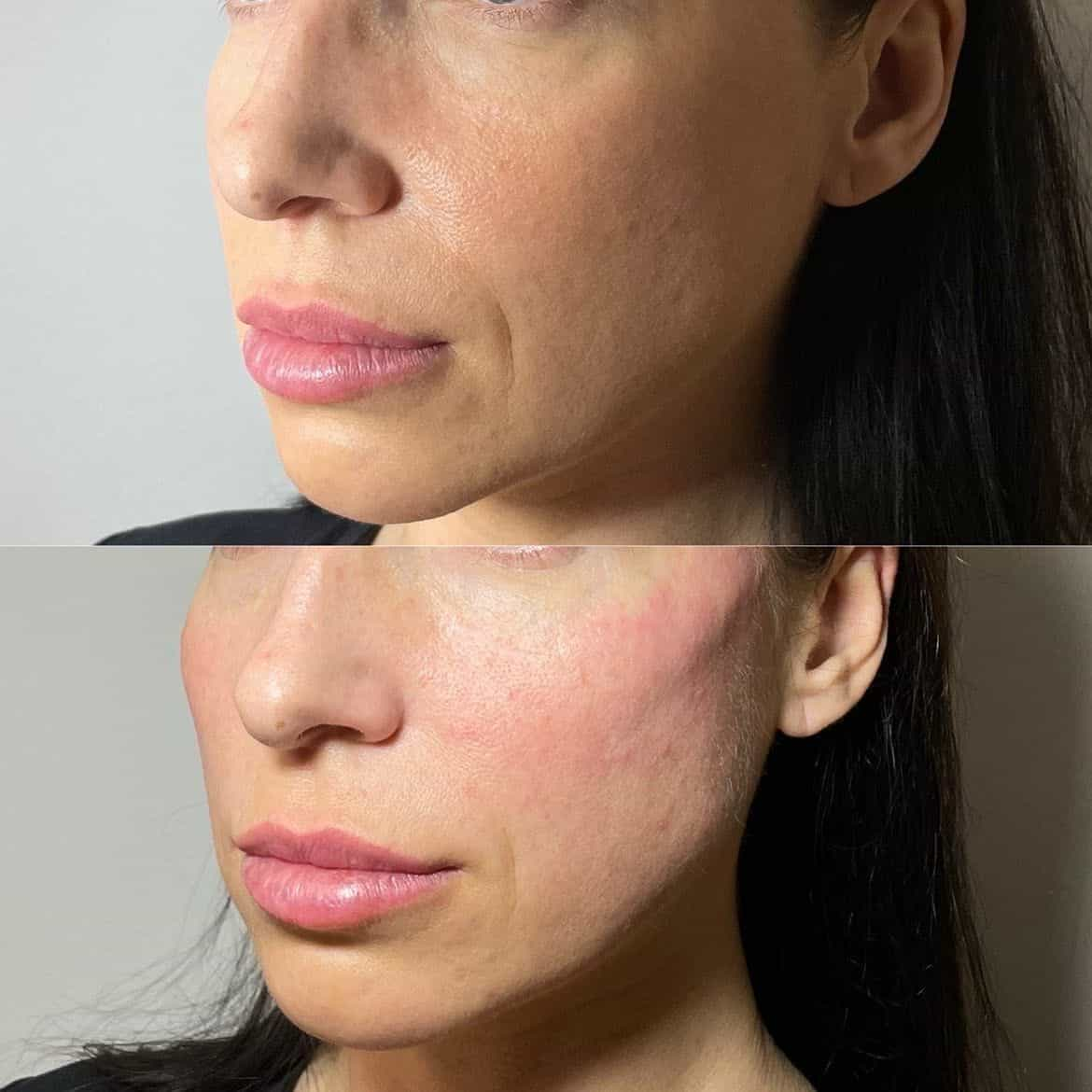
Arrange Your Radiesse Liquid Facelift Session with Dr. Laura Geige Today
What Are Cheek Fillers?
Cheek fillers are dermal fillers made from materials like hyaluronic acid, calcium hydroxylapatite, or poly-L-lactic acid.
Cheek fillers are a type of cosmetic treatment used to add volume and definition to the cheeks, enhancing their natural contours. They are derived from materials that are naturally found in the body or have been engineered for medical use.
The primary ingredient in cheek fillers is hyaluronic acid (HA), which is a naturally occurring substance that can be found in connective tissue throughout the body.
Book a Consultation for Cheek Filler with Dr. Laura Geige at It’s Me and You Clinic
HA has several key properties that make it an ideal ingredient for dermal fillers, including its ability to bind and retain large amounts of water, providing hydration and plumping up the skin.
Another material used in cheek fillers is calcium hydroxylapatite (CaHAP), which is a synthetic variant of HA. CaHAP has been engineered to mimic the structure and function of bone tissue.
Poly-L-lactic acid (PLLA) is another biodegradable synthetic material sometimes used in dermal fillers, including cheek fillers. PLLA can stimulate collagen production over time as it breaks down within the body.
These materials are carefully chosen for their unique properties and safety profiles, providing effective, temporary solutions to add volume or shape to areas like the cheeks without causing long-term harm.
Cheek fillers have become a popular non-invasive treatment in aesthetic medicine due to their versatility, relatively low risk profile compared to surgery, and fast recovery time.
Risks Associated with Cheek Fillers
Serious complications, though rare, include blindness and nerve damage. Common side effects include swelling, bruising, redness, pain, itching, and abscess formation.
The use of cheek fillers has become increasingly popular in recent years as a means to add volume, smooth out wrinkles, and enhance facial contours. However, like any medical procedure, there are risks associated with cheek fillers that patients should be aware of.
One of the most serious complications associated with cheek fillers is blindness. This can occur if the filler migrates from its original placement site to another area of the face, such as an eye, and causes blockage or inflammation. Nerve damage is another rare but serious risk, which can result in numbness, tingling, or permanent loss of sensation.
Common side effects associated with cheek fillers include swelling, bruising, redness, pain, itching, and abscess formation. These symptoms are usually temporary and resolve on their own within a few days to weeks. However, in some cases, these side effects can be more severe and last longer.
Other possible risks associated with cheek fillers include:
* Infection: As with any invasive medical procedure, there is a risk of infection after receiving cheek fillers. This can occur if the filler is contaminated or if proper hygiene procedures are not followed.
* Allergic reactions: Some patients may be allergic to certain components of cheek fillers, which can cause an allergic reaction. Symptoms of an allergic reaction may include hives, itching, swelling, and difficulty breathing.
* Granuloma formation: This is a condition in which the body forms a lump or mass around the filler material. Granulomas can be painful and may require surgical removal.

* Vascular occlusion: If the filler material blocks a blood vessel, it can cause damage to surrounding tissues. This can lead to pain, swelling, and discoloration of the skin.
It is essential for patients to carefully weigh the risks and benefits associated with cheek fillers before undergoing treatment. Patients should choose an experienced and qualified healthcare professional who has a good track record with cheek filler treatments. Additionally, patients should follow pre- and post-treatment instructions carefully to minimize the risk of complications.
Patients should also be aware of their medical history and any underlying conditions that may increase their risk of developing side effects or complications from cheek fillers. This includes conditions such as bleeding disorders, autoimmune diseases, and allergies.
In summary, while cheek fillers can provide excellent results in terms of facial rejuvenation, patients must be aware of the potential risks associated with these treatments. By being informed and taking necessary precautions, patients can minimize their risk of developing side effects or complications and achieve optimal results from their treatment.
A 2019 study by the University of California published in the Journal of Clinical and Aesthetic Dermatology found that nearly 80% of patients experienced some type of side effect after receiving dermal fillers.
The use of cheek fillers has become increasingly popular in recent years, with many individuals seeking to enhance their facial appearance through non-surgical means. However, as with any medical treatment, there are associated risks and potential complications that patients should be aware of before undergoing the procedure.
According to a 2019 study published in the Journal of Clinical and Aesthetic Dermatology, nearly 80% of patients experienced some type of side effect after receiving dermal fillers. The most common adverse events reported included temporary redness, swelling, bruising, and pain at the injection site.
More serious complications can also arise from cheek filler injections, including but not limited to: skin infections, abscesses, granulomas, scarring, and allergic reactions. In rare cases, fillers can migrate or spread from the intended treatment area, causing further disfigurement or asymmetry.
Nerve damage is another potential risk associated with cheek filler injections. This can result in numbness, tingling, or persistent pain around the treated area, which may be temporary or, in some cases, permanent. In extremely rare instances, the injection of fillers into a blood vessel can cause blockage and lead to tissue death.
Reserve Your Cheek Filler Session with Dr. Laura Geige Now
It’s worth noting that certain individuals are at a higher risk for complications following cheek filler injections. These include patients with bleeding disorders, taking anticoagulant medications, or who have previously experienced allergic reactions to fillers.
The skill level of the practitioner administering the injectable filler is also an important factor in determining the risk associated with treatment. Board-certified dermatologists and plastic surgeons are typically well-versed in the latest techniques for minimizing complications while achieving optimal results.
While cheek fillers can be a valuable cosmetic solution for many individuals, it’s essential to approach these treatments with realistic expectations and a thorough understanding of the potential risks involved. By doing so, patients can make informed decisions about their care and minimize the likelihood of adverse events occurring.
Avoiding unnecessary filler injections or opting for more conservative treatment plans may be advisable in some cases. Patients should consult with an experienced practitioner to determine the best course of action for their individual needs and circumstances.
- How Jackie Goldschneider’s RHONJ Gamble Backfired - September 18, 2024
- Nia Sanchez’s Advice For Dealing With Postpartum Depression - September 18, 2024
- Who Should Not Get Cheek Fillers? - September 18, 2024
